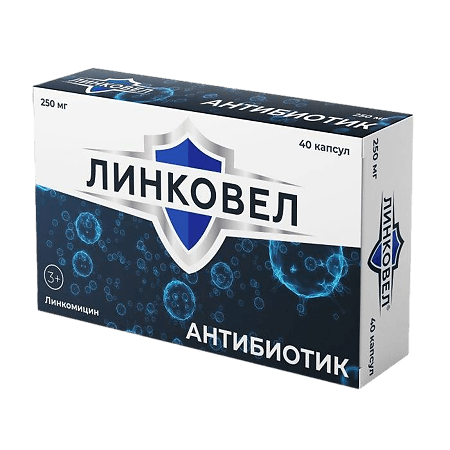No products in the cart.
LingcoVel, 250 mg capsules 40 pcs
€9.36 €8.40
Out of stock
(E-mail when Stock is available)
Description
Pharmacotherapeutic group: lincosamide antibiotic
ATX code: [J01FF02]
Pharmacological properties
Pharmacodynamics
The antibiotic produced by Streptomyces lincolnensis has a bacteriostatic effect. It suppresses protein synthesis of bacteria due to reversible binding to 50S ribosome subunit, disrupts formation of peptide bonds.
Sensitive in vivo: Staphylococcus aureus (penicillin producing and non-producing strains), Staphylococcus epidermidis, Streptococcus pneumoniae.
Sensitive in vitro: aerobic gram-positive microorganisms – Streptococcus pyogenes, Streptococcus spp. group viridans, Corynebacterium diphtheriae; anaerobic gram-positive microorganisms – Propionibacterium acnes, Clostridium tetani, Clostridium perfrigens.
It is effective against Staphylococcus spp. resistant to penicillin, tetracycline, chloramphenicol, streptomycin, cephalosporins (30% of erythromycin-resistant Staphylococcus spp. have cross-resistance to lincomycin).
It has no effect on Enterococcus spp. (including Enterococcus faecalis); Neisseria gonorrhoeae, Neisseria meningitidis, Haemophilus influenzae and other gram-negative bacteria, as well as fungi, viruses, protozoa.
Optimum action is in alkaline environment (pH ‑88.5).
Resistance to lincomycin develops slowly. In high doses it has a bactericidal effect.
There is a cross-resistance between lincomycin and clindamycin.
Pharmacokinetics
Absorption is 30-40% (eating slows down the rate and extent of absorption). Time of reaching maximum concentration of the drug in plasma (TCmax) – 2-3 hours. It penetrates well into lung, liver and kidney tissues, through the placental barrier and into breast milk. It is found in high concentrations in bone tissue and joints. Through the blood-brain barrier lincomycin penetrates only slightly, with meningitis permeability increases. However, lincomycin concentrations in cerebrospinal fluid are not sufficient for treatment of meningitis. It is metabolized in the liver. It is ‑excreted unchanged and as metabolites through the gastrointestinal ‑tract and in the urine.
The elimination half-life is about 5 hours. In liver and kidney diseases the half-life is increased, a significant individual variability in the dynamics of plasma lincomycin concentration ‑is observed. In renal insufficiency (terminal stage) the half-life period is 1020 ‑hours; in liver function disorders it is 8-12 hours.
It is excreted unchanged and as metabolites in the bile and kidneys.
Patients of advanced age. Pharmacokinetics in elderly patients with normal hepatic and renal function corresponds to the pharmacokinetics of adult patients.
Indications
Indications
Active ingredient
Active ingredient
Composition
Composition
How to take, the dosage
How to take, the dosage
For children aged 3 to 12 years (with a body weight of 20 kg to 40 kg) the daily dose is 30-60 mg/kg. Duration of treatment depending on the form and severity of the disease is 7-14 days (with osteomyelitis – 3 weeks or more).
Interaction
Interaction
Special Instructions
Special Instructions
Synopsis
Synopsis
Contraindications
Contraindications
Side effects
Side effects
“hepatic” transaminases; with long-term use – gastrointestinal candidiasis, pseudomembranous colitis.
If any of the side effects listed in the instructions worsen, or any other side effects not listed in the instructions are noticed, tell your doctor.
Overdose
Overdose
Symptoms: possible intensification of dose-dependent side effects.
Treatment: gastric lavage, activated charcoal, symptomatic therapy. There is no specific antidote.
Poorly removed by hemo- and peritoneal dialysis.
Pregnancy use
Pregnancy use
Similarities
Similarities
Additional information
| Weight | 0.038 kg |
|---|---|
| Shelf life | 3 years. Do not use after the expiration date. |
| Conditions of storage | In a light-protected place at a temperature not exceeding 25 oC. Keep out of the reach of children. |
| Manufacturer | Welfarm, Russia |
| Medication form | capsules |
| Brand | Welfarm |
Related products
Buy LingcoVel, 250 mg capsules 40 pcs with delivery to USA, UK, Europe and over 120 other countries.















